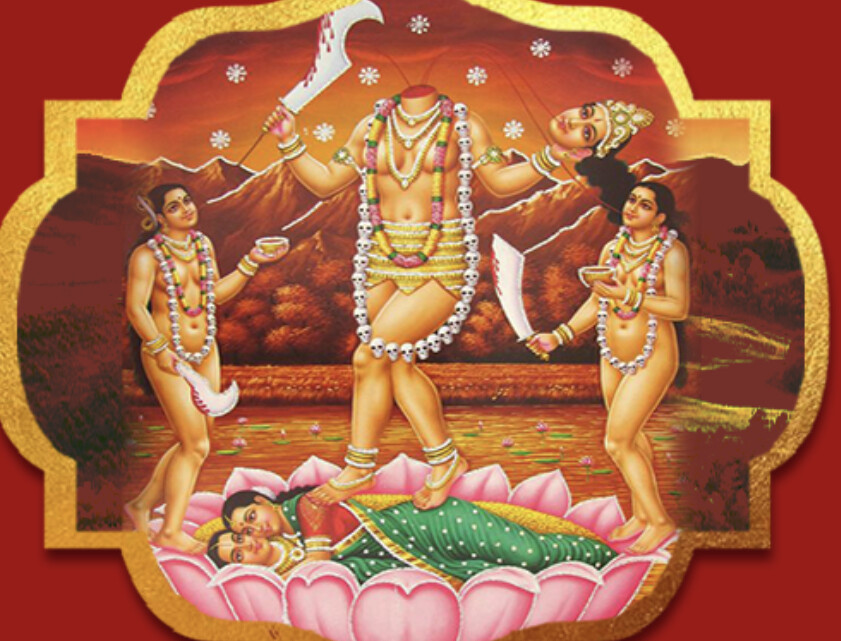Chinnamasta Mahavidya Homam & Narasimha Avatara Homam are two powerful rituals that bring glory, peace and abundance in life. These pious fire rituals fulfil life with happiness and peace.
About the great Chinnamasta Mahavidya
Chinnamasta is a supreme goddess and one of the ten Mahavidyas, representing the power of transformation. She is also known as Chinnamastika and Prachanda Chandika.
Chinnamasta is depicted as a fierce goddess who is usually depicted standing or sitting on a lotus. Her most distinctive feature is that she is shown as having cut off her head, which is held in one hand while blood spurts out of her neck, and is drunk by her severed head and two attendants flanking her.
The symbolism behind Chinnamasta’s self-decapitation is complex and has various interpretations. Some interpretations suggest that the act represents the goddess’s ability to transcend the physical body’s limitations and achieve spiritual liberation. Others suggest that it symbolizes the goddess’s ability to sever the ties of attachment and desire, allowing one to attain enlightenment.
Chinnamasta is often worshipped by those seeking transformation and liberation from worldly attachments. She is also associated with the element of air and the energy of the throat chakra, which governs communication and self-expression.
In some traditions, Chinnamasta is also associated with the Tantric practices of death, which are seen as paths to spiritual liberation. However, it is essential to note that the symbolism and practices associated with Chinnamasta are complex and require proper understanding and guidance to be approached with respect and care.
About supreme Lord Narasimha
Lord Narasimha is one of the ten incarnations of Lord Vishnu, who appeared on earth to protect his devotees from evil forces. He is depicted as half-man and half-lion, with a fierce expression, symbolizing the destruction of evil and the protection of righteousness. The story of Lord Narasimha is mentioned in various Hindu scriptures, including the Bhagavata Purana, where it is believed that he appeared to save his devotee Prahlada from his demonic father, Hiranyakashipu. Lord Narasimha is worshipped across India, and his temples are famous for their intricate architecture and spiritual significance.
Lord Narasimha is regarded as a divine embodiment of fearlessness and protection. Devotees often invoke him to overcome fear, anxiety, and obstacles in their lives. The chanting of Narasimha mantras is believed to invoke his divine presence and offer protection to his devotees. The most famous mantra associated with Lord Narasimha is the Narasimha Maha Mantra – “Ugram Veeram Mahavishnum Jvalantam Sarvato Mukham, Nrisimham Bhishanam Bhadram Mrityur Mrityum Namamy Aham,” which means “I bow down to Lord Narasimha who is fierce, powerful, and all-pervading. He destroys fear, and death bows down to him.”
Significance of Chinnamasta Mahavidya Homam & Narasimha Avatara Homam
The Chinnamasta Mahavidya Homam is a powerful homam that can be performed to attain the blessings of the goddess. The Narasimha Avatara Homam is a homam that can be performed to obtain the blessings of Lord Vishnu. These homams are known to bring favorable results in one’s life, making them very popular among devotees.
Chinnamasta Mahavidya Homam is a powerful Vedic ritual dedicated to the Goddess. The mighty Chinnamasta is one of the ten Mahavidyas. She is known as the self-decapitated goddess, and the worship of Chinnamasta is believed to grant spiritual awakening, protection, and victory over enemies. The ritual involves chanting sacred mantras and offering various items, including flowers, fruits, and ghee, into a fire. The homam is believed to remove negative energies, promote positivity, and enhance spiritual awareness.
Narasimha Avatara Homam is a sacred ritual performed to worship Lord Narasimha, who is an incarnation of Lord Vishnu. Lord Narasimha is known for his fierce form, which he took to protect his devotee Prahlada. The homam involves chanting Narasimha mantras and offering ghee, flowers, and other sacred items into a fire. It is believed that the homam grants protection, removes obstacles, and promotes positivity in one’s life.
Both Chinnamasta Mahavidya Homam and Narasimha Avatara Homam are significant rituals that offer spiritual and worldly benefits to devotees who perform them with devotion and sincerity.
Boons of Chinnamasta Mahavidya Homam & Narasimha Avatara Homam
Chinnamasta Mahavidya Homam and Narasimha Avatara Homam are two important rituals believed to bring numerous benefits to the worshipper. Here are some of the boons of performing these homams:
Chinnamasta Mahavidya Homam is performed to worship Goddess Chinnamasta, who is known as the goddess of self-sacrifice. By performing this homam, one can receive the blessings of the goddess and gain the following benefits:
-
Protection from evil forces and negative energies.
-
Removal of obstacles and hurdles in life.
-
Attainment of spiritual growth and enlightenment.
-
Improvement in financial stability and prosperity.
-
Protection from accidents and mishaps.
Narasimha Avatara Homam is performed to worship Lord Narasimha, who is believed to be an incarnation of Lord Vishnu. By performing this homam, one can receive the blessings of the lord and gain the following benefits:
-
Protection from enemies and evil forces.
-
Removal of fear and anxiety.
-
Attainment of courage, strength, and confidence.
-
Improvement in overall health and well-being.
-
Fulfillment of desires and wishes.
Both Chinnamasta Mahavidya Homam and Narasimha Avatara Homam are powerful rituals that can benefit the worshipper. It is essential to perform these homams with sincerity, devotion, and proper guidance from a knowledgeable priest.
Get in touch with us
If you wish to gain all the above boons, then connect with us. We will execute Chinnamasta Mahavidya Homam & Narasimha Avatara Homam for you in the best possible way. So, without further wait, connect with us and rep endless boons.
Register here- https://bit.ly/41LqZ5Y

















